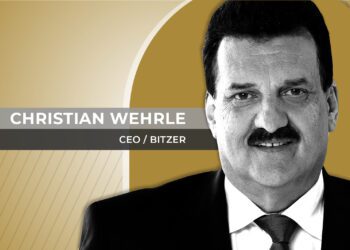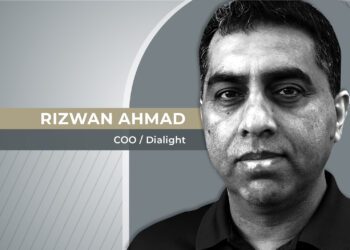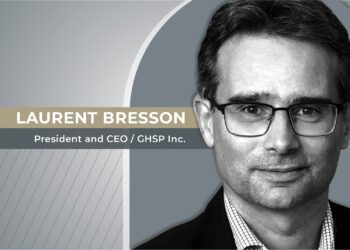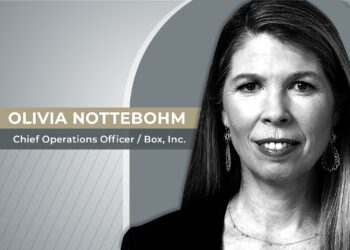

Andrew Littlefair
President and CEO / Clean Energy Fuels
When you think of renewable, low-carbon energy sources, the first thoughts that come to mind might be solar, hydroelectric, or hydrogen. But Clean Energy Fuels leads the way in the North American transportation industry with a source of power that’s practical and realistic right here, right now — renewable natural gas.
For more than 25 years, this Newport Beach, California-based company has provided this fuel source made from organic waste to power 25,000 heavy-duty trucks, buses, and large vehicles every day.
“As transportation looks to decarbonize, there’s an answer that’s here today — that we don’t have to wait for technology, we don’t have to wait for the perfect buildout of electric infrastructure,” says Andrew Littlefair, president and CEO of Clean Energy. “I think it’s key to let people know that renewable energy is the lowest — by far the lowest — carbon fuel that’s available today.”
Clean Energy operates over 600 fueling stations in 42 states, employs 566 people, and brings in about $425.2 million annually (with $106.9 million in the fourth quarter of 2023), but the company started small. In the ‘90s, Littlefair worked for T. Boone Pickens Jr., the president of Mesa Petroleum, which would later become Mesa Oil and Gas. “Boone understood that the properties of natural gas are cleaner, cheaper, domestic,” Littlefair explains, describing Boone as having innate economic skills and the geology background to understand the properties of natural gas. When Mesa was recapitalized in 1997, the two of them followed their instincts to pursue business for themselves in natural gas as a transportation fuel. Littlefair left Dallas and headed to California, which he says even then “was on the forefront” of the sustainability movement.
“I think it’s key to let people know that that renewable natural gas is the lowest — by far the lowest — carbon fuel. It’s available today. It’s moved in America’s pipeline system all across the country.”


That was where Littlefair founded Clean Energy. Serving as the company’s sole employee, he used Boone’s capital and bought two stations from Mesa while making a bid on 30 natural gas fueling stations from the Southern California Gas Company. “That sort of gave us enough critical mass to get the company started, and we began to grow from there — all in 1997,” he recalls.
Because he was “pigheaded enough,” in his own words, to stick with it, Clean Energy grew. “What gave us an edge and maybe helped us stay in the business as long as we have was that we stayed focused, and we focused on those fleet vehicles that used a lot of fuel,” he says. Think taxi cabs, transit buses, and refuse trucks.
“Today, 91% of all the fuel that we sell is RNG, renewable natural gas. It’s not fossil natural gas. That low-carbon RNG could have a carbon intensity that’s five times, six times lower than diesel. It’s four times lower than an electric truck. It’s four or five times lower than a hydrogen truck.”


Clean Energy really started to grow in 2014, once it turned its attention to heavy-duty engines for over-the-road trucking, goods movement, and class-A trucks. It started developing the proper infrastructure in the form of fueling stations. This was also when Clean Energy moved from conventional natural gas to renewable natural gas, starting with cleaning up gas coming out of a landfill in Dallas. “Today, 91% of all the fuel that we sell is RNG — renewable natural gas,” Littlefair says.
The benefit of RNG is twofold: For starters, it’s made from methane, a greenhouse gas, which is captured before it can enter and damage the planet’s atmosphere. Not only does this reduce greenhouse gases, but it also reduces the need for dirty diesel and gasoline fuel sources for cars. This combination of factors means it’s able to reduce carbon emissions by an average of 300% versus diesel, and it does this at a fraction of the price.
Production of RNG is one way in which Clean Energy is proving itself a changemaker in the industry.


“We have joint venture with BP and Total Energies, major energy companies, to develop RNG digesters at dairy farms,” Littlefair explains. “We’re harnessing the manure from a dairy farm. We put it in a digester, clean it up a little bit, and put it in the pipeline. And that is this low-carbon fuel.”
And it’s a fuel source that Littlefair points out more and more drivers are depending on. “For instance, almost all the heavy-duty trucks UPS bus operate on RNG,” he says, adding, “They have 16,000 over-the-road trucks that use nothing but renewable natural gas.”
Within the company, Littlefair has a team of smart, forward-thinking leaders. Among them, he praises Bart Frabotta, the senior vice president who is responsible for the company’s engineering operations, construction, and supply chain. Directly under Frabotta is Rene Martin, a supply chain expert who Littlefair says helps “wring the cost out of some of those RNG projects,” by promoting better efficiency and developing better strategies.
“We’ve long understood that we needed to have very close relationships with the OEMs, the original equipment manufacturers, in engines and in vehicles. We’ve often been a co-op. We’ve had ventures and collaborations with the OEMs to test vehicles and to test stations and others.”


“I feel like we’re very fortunate that we’ve been able to stay in the business, grow the business, and arrive at a point in time where we have the cleanest lowest-carbon commercial fuel in the world,” Littlefair says.
With that, there’s plenty of potential to grow in the future.
“We were pigheaded enough to stick with this business, you know, through high and low oil prices. Of course, you know, today the concern is about the climate and green transition —we didn’t talk about reducing carbon when we started the company. … We knew that at its core, natural gas was a was a good fuel.”


Littlefair points out that heavy-duty vehicles in the United States use between 40 and 45 billion gallons of fuel a year, making a huge target market for a company like Clean Energy. Currently, about 50,000 heavy-duty trucks power themselves with Clean Energy’s fuel, but America buys 250,000 over-the-road trucks per year, so the target is to offer RNG a viable fuel source for as many of those trucks as possible.
It’s a prospect that has Littlefair excited and ambitious. He acknowledges that RNG might not be the best-known renewable source in cultural discourse right now, but it’s only a matter of educating people. “If you just read the newspaper, you would think that everything’s getting ready to be electric,” he says. “But what I’d like people to know is there is a lower cost, lower carbon solution that’s available today that will get the work done that America’s transportation fleets need to get done. We don’t have to wait for advanced technology. We’re ready to go today.”
















